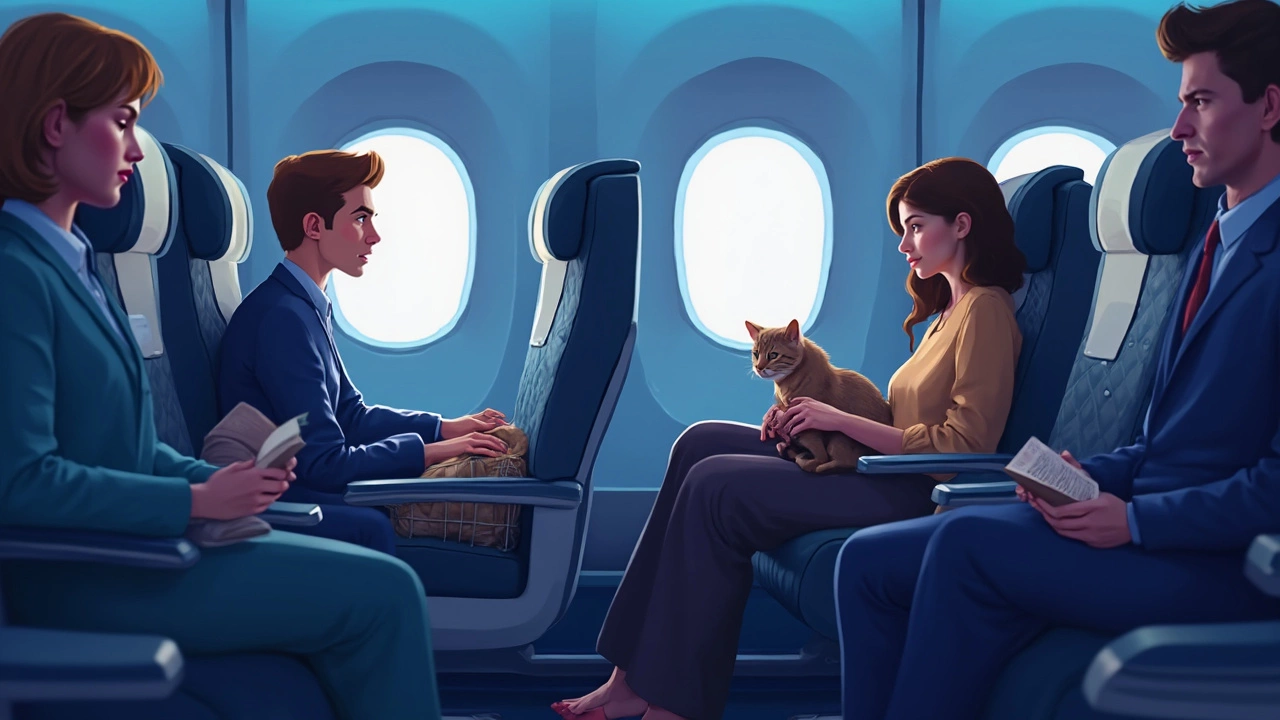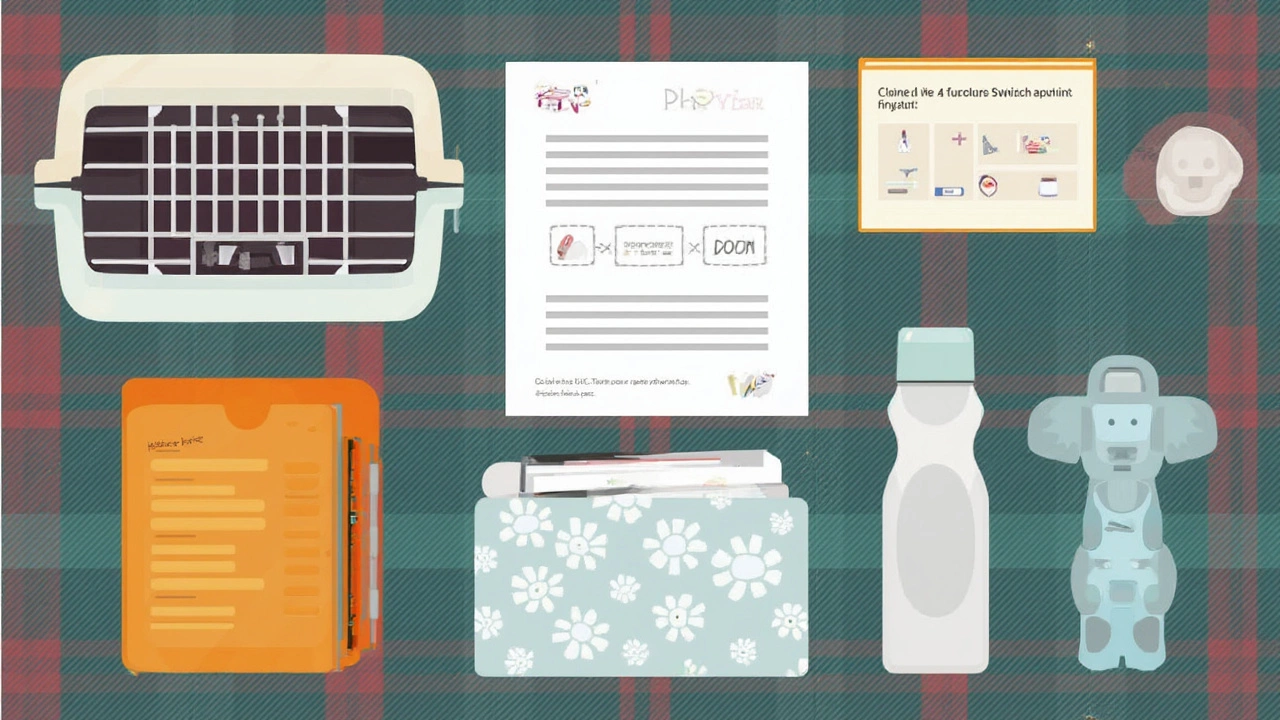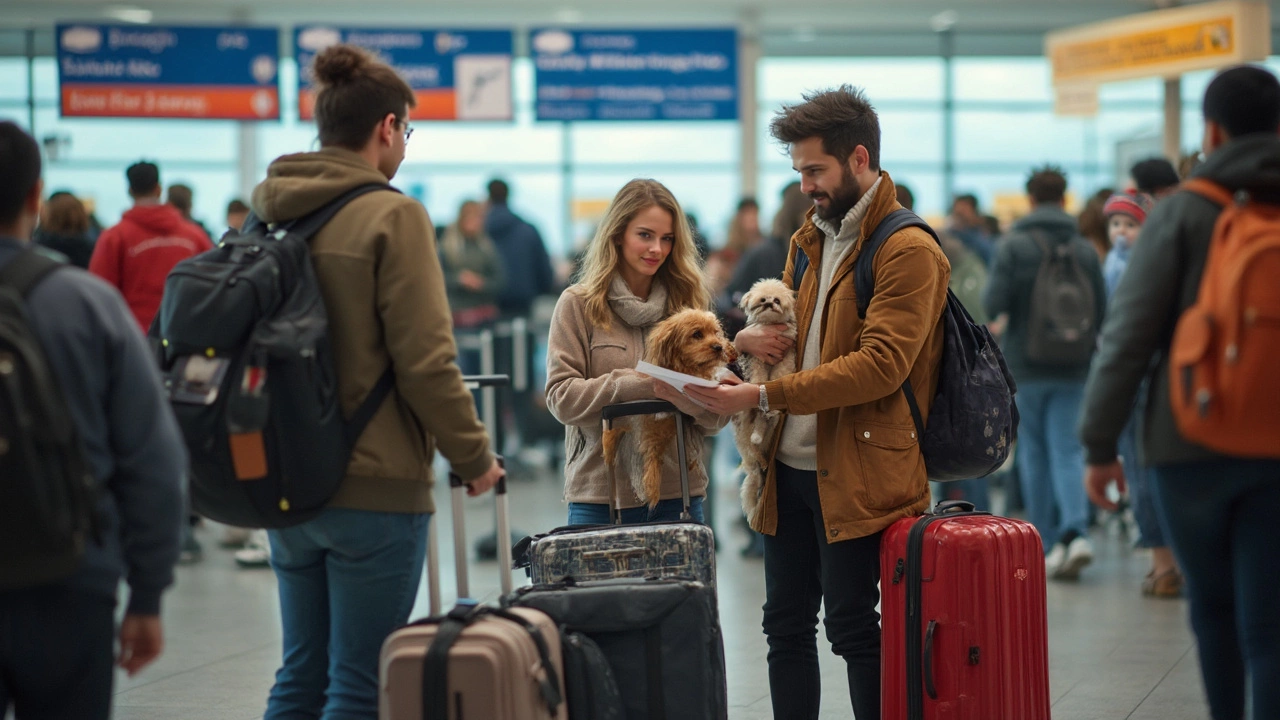Ever found yourself stressed just looking at airline pet rules? You’re definitely not alone. Flying with a pet can be a challenge if you show up unprepared—or breeze through, if you’ve got the right info. Airlines set different rules for pets, and they don’t make it easy to find the real costs, cabin/cargo options, or paperwork requirements.
Before you even book your ticket, always check if your airline allows your pet’s species and size. Dogs and cats usually get in, but rabbits or parrots? Not always. Cabin spots for pets fill up fast. Sometimes, only 2-4 animals are allowed per flight, so waiting means risking no space for your furry friend. Plus, fees can get steep—think $100 to $200 or more, each way, just for a domestic trip.
Don’t forget about the carrier. Airlines have strict size rules. Your carrier must fit under the seat in front of you. It can’t be too tall or too wide, and they’ll often measure it at check-in. If it doesn’t fit, your pet may have to ride in cargo, which is a different level of stress for both you and your animal. Always check measurements before you buy a carrier—every inch matters.
- What Airlines Require: Rules and Fees
- Choosing the Right Carrier
- Getting Your Pet Ready
- How Flying Affects Pets
- Tips for a Smooth Journey
What Airlines Require: Rules and Fees
This is where stuff gets real. Every airline handles flying with pets a bit differently, and sometimes it feels like you need a detective badge just to figure out what’s allowed. Here are the basics you really have to check before buying any ticket.
- Pet type and size: Most airlines let only cats and dogs in the cabin. If you have a guinea pig, bird, or something more exotic, expect lots of ‘no’s. Check your airline’s website for allowed pet species and breeds. Some flat-faced breeds like pugs and Persian cats face stricter rules due to breathing risks.
- Cabin vs. Cargo: Small pets that fit in a carrier under the seat can usually fly in the cabin. If your animal is bigger, you’re looking at cargo, which can be pricier and more stressful for pets.
- Carrier size: Every airline puts out carrier dimensions for the cabin. These matter—a lot. Your carrier has to fit under the seat or it’s a no-go. If you’re not sure, bring a tape measure to the pet store.
Now, about those fees. Airlines almost never let pets fly for free, and the prices jump fast. Here’s a quick look at what you can expect if you’re traveling domestically in the US:
| Airline | Cabin Pet Fee (One-Way) | Max Carrier Size (inches) |
|---|---|---|
| Delta | $95 | 18 x 11 x 11 |
| American | $125 | 19 x 13 x 9 |
| United | $125 | 17.5 x 12 x 7.5 |
| Southwest | $95 | 18.5 x 8.5 x 13.5 |
| JetBlue | $125 | 17 x 12.5 x 8.5 |
Remember, these fees are just for the pet. They don't count towards your normal carry-on or checked bag allowance. So if the airline lets you bring one carry-on, your pet carrier is it. Want your laptop bag too? You’ll probably have to check it.
Some airlines also need you to call ahead to reserve a spot for your pet travel. They only let a certain number of animals in the cabin, and booking online doesn’t always guarantee your pet’s spot. If you skip this, you could get to the airport and have your pet denied at check-in. Not a fun way to start a trip.
International flights get even trickier. Most countries require health certificates, vaccination records (especially rabies), and sometimes even quarantines. Airlines have zero wiggle room on this stuff—they get hit with fines if your paperwork isn’t perfect. Always check both your airline and the government site of wherever you’re going if you’re crossing borders with a pet.
Choosing the Right Carrier
Picking the best carrier isn’t about being fancy—it’s about meeting airline rules and protecting your pet. Every airline has its own size limits, so don’t just trust the label that says “airline-approved.” For most major U.S. airlines, the carrier usually needs to be under 18 inches long and around 11 inches tall, but always check your specific airline’s website before buying.
There are two main types: soft-sided and hard-sided. Soft carriers can squeeze into tight spaces better, which matters since the airplane pet rules require the carrier to fit under the seat in front of you. But make sure your pet can turn around and lie down inside—airlines actually check for that. Hard-sided ones offer more protection but can sometimes be too big for the cabin space.
- Look for good ventilation—at least two sides should have mesh panels. Your pet needs to breathe and stay cool, especially during delays.
- Secure zippers are a must. Some pets pull Houdini moves with weak zippers.
- Add something comfy inside. Many owners use a familiar blanket or a pee pad, especially for nervous pets.
Don’t guess about the weight limit—most airlines cap it at around 15 to 20 lbs, including your pet carrier and the pet inside. And never use a carrier your pet’s never been in before the actual flight. Let them nap in it at home to get used to the smell and space.
| Airline | Max Carrier Size (inches) | Weight Limit (lbs) |
|---|---|---|
| American Airlines | 18x11x11 | 20 |
| Delta | 18x11x11 | 18 |
| Southwest | 18.5x8.5x13.5 | 15 |
| United | 18x11x11 | 20 |
Always write your contact info on the carrier, just in case. The right pet carrier makes the entire journey smoother for everyone—even the passengers around you.

Getting Your Pet Ready
Prepping your pet for a flight isn’t just about buying a ticket—you also need some solid prep work to avoid last-minute chaos. Airlines want up-to-date health records, especially rabies and vaccination papers, even for flying with pets inside the country. If you’re traveling internationally, add microchipping, special vaccines, or parasite tests to your to-do list. Some countries have a quarantine requirement, and you really don’t want a surprise quarantine ruining your trip.
Getting your pet used to their pet carrier is one of the best things you can do. Most airlines require your pet to stay in the carrier the entire time, from airport check-in to baggage claim. If your dog or cat sees the carrier as a safe place (not kitty jail), you’ll have a way calmer experience.
- Start by leaving the carrier out at home for a week or two. Toss in treats and toys so your pet starts hanging out inside by choice.
- Take your pet on short car rides in the carrier. This reduces their stress with movement and noise.
- Work up to longer practice runs, like an hour drive with the radio on.
Food can be tricky. Feed your pet about four hours before check-in to avoid air sickness, but skip a big meal right before the airport. Always bring a non-spill water bowl, since dehydration is no joke—even in the cabin.
For some anxious pets, calming options help. Vets sometimes suggest pheromone sprays, or anti-anxiety gear like ‘thunder shirts.’ Meds aren’t a go-to, though—they can mess with pet travel safety. Always ask your vet before giving anything.
| Prep Step | Recommended Timing |
|---|---|
| Health check & vaccines | 1-2 weeks prior |
| Carrier familiarization | 2-4 weeks prior |
| Short carrier rides | 2-3 weeks prior |
| Final vet checkup | 3 days prior |
The reality? If you prep in advance, pet anxiety and travel headaches drop fast. You’ll both walk into the airport more chill, and way more ready for security lines and waiting lounges.
How Flying Affects Pets
Flying isn’t just stressful for humans—flying with pets comes with its own set of challenges for the animals, too. The loud noises, strange smells, and sudden changes in air pressure can leave even the bravest pup or kitten super anxious. Some pets might pant, shiver, whine, or hide in their carrier. Others may seem totally fine until takeoff, and then panic out of nowhere.
Cabin temperatures tend to stay steady, but pets in the cargo hold deal with bigger changes. Temperature swings and loud cargo noises are a real thing. Short-nosed breeds, like Frenchies and Persians, are especially at risk for breathing issues on flights. For this reason, several airlines don’t allow certain breeds in cargo at all.
Pet anxiety spiking during a flight is common, and some animals may get physically sick—think upset stomachs or accidents in their carrier. It’s totally normal, and usually no big deal, but bringing a puppy pad or two can be a lifesaver. Vets say it helps to skip breakfast the morning of a flight to lower the chance of motion sickness, especially for dogs and cats.
It’s not just nerves. A study by the Center for Pet Safety in 2022 found that about 36% of pets showed high stress signs while traveling by air. This includes heavy panting, paw licking, and even loss of appetite for a day or two afterward. If you notice changes in your pet after flying, chances are it’s just a reaction to all the weirdness, and most get back to normal soon.
Here’s what you can try to make things easier for your furry travel buddy:
- Pick a direct flight if you can—layovers add stress and more time in the carrier.
- Ask your vet about calming treats or sprays, especially if your pet’s already anxious in the car or new places.
- Give your pet lots of chances to potty right before heading to the airport.
- Bring an old T-shirt or blanket that smells like home to comfort your pet.
Watching your pet for signs of distress and talking to your vet before flying can really help you plan and avoid problems. Helping them feel a little more secure makes the experience way smoother for everyone involved.

Tips for a Smooth Journey
If you want your flying with pets experience to go as smoothly as possible, every detail counts. The difference between a stressful trip and an easy one often comes down to the steps you take before you reach the airport.
First, get your pet used to the pet carrier early. Leave it open at home with their favorite blanket or toy inside. Some owners even feed their pet in the carrier for a week or two before the flight. The goal is to make it feel like a safe zone, not a jail sentence.
Booking a direct flight, whenever possible, can save a ton of hassle. Every layover adds risk for delays and increases the chances of your pet getting unsettled. Plus, some airlines only allow pets on certain routes or at certain times of day, since temperature in the cargo hold can get dangerously high in summer or freezing in winter.
Here’s what you’ll want in your carry-on for in-cabin pets:
- Absorbent pads (in case of accidents)
- A spill-proof water bowl or bottle
- Few treats and a familiar toy
- Copies of your pet’s vaccination records and health certificate
- Extra leash and poop bags
If your pet has anxiety, talk to your veterinarian before the trip. Vets sometimes recommend calming supplements, though sedation is rarely advised because it can make things worse up in the air. Instead, try a Thundershirt or pheromone spray—plenty of pet parents swear by these for reducing pet anxiety during flights.
Another smart move: check in early. Not only will this help you beat lines, but in some cases, pet check-in desks close an hour before regular passengers. TSA might ask you to take your pet out of the carrier for security, so have a harness or leash on hand to keep them from bolting.
Statistically, the vast majority of pets—over 99%—arrive safely when flying, according to the latest U.S. Department of Transportation reports. But mistakes can happen. Make sure your carrier is well-labeled with your name, phone number, and destination. Attach a photo of your pet, just in case.
Once you’re at your gate, keep your pet calm and talk to them soothingly. Stay away from busy areas with lots of foot traffic. After landing, offer water right away since plane air is super dry. Watch for signs of stress or overheating, and get out of the airport as soon as possible. Sometimes just seeing grass again makes all the difference to a nervous animal. With these tips, you and your pet are more likely to arrive at your destination happy, healthy, and way less frazzled.
